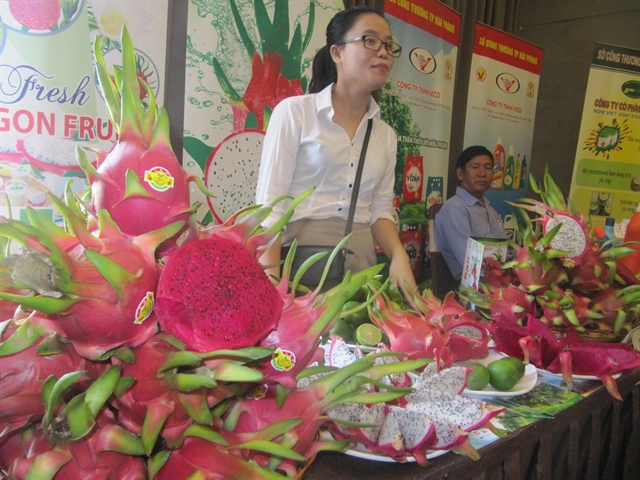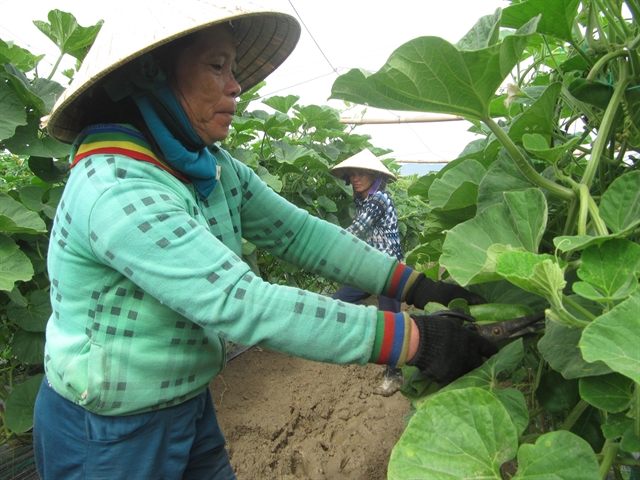 Economy
Economy

 |
| A conference on trade promotion and import-export development in the central region drew the participation of businesses and exporters seeking better links and to share in market information. Photo courtesy of Xuân Hoài |
ĐÀ NẴNG — With an economy of VNĐ1.57 trillion (US$61.7 million), or 15 per cent of the country’s Gross Domestic Product, and growing 5.5 per cent annually, the north central and coastal central region is seeking to assert itself as a strategic sea-based economic power and a global brand of logistics, tourism and industrial processing.
Deputy Minister of Industry and Trade, Phan Thị Thắng said at a conference on trade promotion and import-export development held in Đà Nẵng last week that the region is making great efforts to turn it into a ‘smart’ and ‘green’ industrial and international co-operation destination by 2050.
“The region has key industries of semiconductors, coastal tourism, renewable energy, logistics and sea ports. It is also a leading region in sustainable development in the Government’s Master Plan for 2021-30, with a vision to 2050,” Thắng said.
“It has achieved stable growth and an import-export turnover of $46.7 billion in 2023, and attracted foreign direct investment of $3 billion in the last five years,” she added.
Thắng said the region was assigned to develop two key giant urban and several international centres of industry and services with a ‘smart’ and ‘green’ urban network.
 |
| A pavilion introduces red dragon fruit at a business forum in Đà Nẵng. Fruit and vegetable products of Việt Nam are seen as key exports with revenue of US$3.3 billion in the first half of 2024. VNS Photo Công Thành |
She said that the region's sea-based economy and the operation of industrial zones have not yet reached their full potential.
Tourism in the region still lacks unique products and services to grab the attraction of global travellers, and powerful inter-regional institution policy is needed for a rapid boost in revenue growth and investment, she said.
Huỳnh Tấn Hải, Director of Khánh Hoà's provincial industry and trade department, said the coastal province has yet to develop a key port for exports, and most exports from the region are still loaded at key ports in HCM City.
He asked the ministry and the Government to speed up a plan to develop a series of key ports and logistics centres in the region to create favourable conditions for export and import.
Deputy Director of Quảng Nam Province’s Department of Industry and Trade Hường Văn Minh said the province has been calling for investment in logistics infrastructure and traffic systems to build good connections between the central and Central Highlands provinces and Laos, Thailand and Cambodia via provincial border check-points.
He said the province saw trade turnover of $13.3 billion last year, and a system of airports and sea ports have been upgraded to facilitate trade.
Phan Hoài Nam from Quảng Bình Province shared that sea ports and logistics centres should be developed to boost exports of the farm produce, forestry products and seafood of the region.
Director of Tiền Giang Provincial Department of Industry and Trade Lưu Văn Phi called for better business and investment links among the central provinces and the Mekong Delta region via Tiền Giang.
He said the province offers investment opportunities in processing industries and international standard logistics, food and aquatic product storage technology as well as e-commerce.
 |
| A farmer collects vegetables at a farm in central Việt Nam. The coastal central region has potential in industrial production and farm produce for export. VNS Photo Công Thành |
Chairman of Việt Nam’s Fruit and Vegetable Association (Vinafruit) Nguyễn Thanh Bình said fruit and vegetable exports achieved impressive sales of more than $3.3 billion in the first half of 2024, but stable quality and safe conditions must be seriously considered.
He warned that the overuse of pesticide and plant protection is still identified by sample tests by importers.
The country has 2.2 million hectares of vegetable and fruit farms with more than 30 million tonnes of product, but the latest technology has yet to be applied at all farms and processing factories.
“We have only 156 high-tech factories, or 20 per cent of total processing plants, while 7,000 manual processing centres still remain. It’s a disadvantage for the country’s fruit and vegetable exports,” Bình explained.
He also said export markets should be diversified to avoid risk as China accounts for 80 per cent of Việt Nam’s fruit and vegetable exports annually.
Bình said South Korea, the US and Europe have recently emerged as potential markets for farm produce as well as fruits and vegetables from Việt Nam.
He also asked for more businesses links and market information exchanges through embassies in key markets, and ‘green’ transition in production as well as digitalisation in trade.
The chairman requested setting up food safety standards for 2 million farming households producing qualified export products.
He also warned that the master plan for durian must be strictly reviewed as local farmers have grown 150,000ha, more than the designed plan of 90,000ha.
The Ministry of Industry and Trade will continue to support regional provinces in seeking wider export markets, promotions, human resources training and digital transformation in the coming time. — VNS




